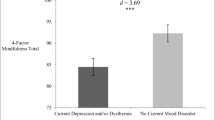Abstract
Anomalous bodily experiences and automaton-like feelings constitute some of the core symptoms of depersonalization disorder (DP), features which may be considered antithetical to mindfulness. We thus investigated traits in a random sample of 22 stable patients with DP using the 14-item Freiburg Mindfulness Inventory (FMI) and predicted an overall negative correlation to their symptomatology as measured by the Cambridge Depersonalization Scale (CDS). We also conducted a regression analysis in order to elucidate the contribution of depression and anxiety measures on the above-mentioned correlation. Overall, the FMI and CDS were strongly negatively correlated (Pearson’s r = −.64, p < .001) as predicted, driven particularly by FMI items 1–4 and 7. The correlation withstood adjustment for depression and anxiety symptoms using regression analysis (R 2 adj = 33 %; F (1, 19) = 10.83, p < .005). In sum, our results suggest a possible impairment of mindfulness abilities in DP. Future research should explore the links between DP and psychopathology and seek to devise therapeutic interventions for DP based on mindfulness.
Similar content being viewed by others
References
Allen, J. G. (2004). Coping with trauma: hope through understanding (2nd ed.). Washington, DC: American Psychiatric Press Inc.
Baer, R. A., Smith, G. T., & Allen, K. B. (2004). Assessment of mindfulness by self-report: the Kentucky inventory of mindfulness skills. Assessment, 11(3), 191–206. doi:10.1177/1073191104268029.
Beck, A. T., & Steer, R. A. (1984). Internal consistencies of the original and revised Beck depression inventory. Journal of Clinical Psychology, 40(6), 1365–1367.
Beck, A. T., Epstein, N., Brown, G., & Steer, R. A. (1988). An inventory for measuring clinical anxiety: psychometric properties. Journal of Consulting and Clinical Psychology, 56(6), 893–897.
David, A., Baker, D., & Hunter, E. (2007). Overcoming depersonalization and feelings of unreality: a self-help guide using cognitive behavioral techniques. London: Robinson.
Dubester, K. A., & Braun, B. G. (1995). Psychometric properties of the dissociative experiences scale. Journal of Nervous and Mental Disease, 183(4), 231–235.
Farb, N. A. S., Anderson, A. K., & Segal, Z. V. (2012). The mindful brain and emotion regulation in mood disorders. Canadian Journal of Psychiatry, 57(2), 70–77.
Hunter, E. C. M., Sierra, M., & David, A. S. (2004). The epidemiology of depersonalisation and derealisation—a systematic review. Social Psychiatry and Psychiatric Epidemiology, 39(1), 9–18. doi:10.1007/s00127-004-0701-4.
Kohls, N., Sauer, S., & Walach, H. (2009). Facets of mindfulness—results of an online study investigating the Freiburg mindfulness inventory. Personality and Individual Differences, 46(2), 224–230. doi:10.1016/j.paid.2008.10.009.
Michal, M. (2014). Depersonalisation und Derealisation: Die Entfremdung überwinden. Stuttgart: Kohlhammer W.
Michal, M., Beutel, M. E., Jordan, J., Zimmermann, M., Wolters, S., & Heidenreich, T. (2007). Depersonalization, mindfulness, and childhood trauma. Journal of Nervous and Mental Disease, 195(8), 693–696. doi:10.1097/NMD.0b013e31811f4492.
Michal, M., Koechel, A., Canterino, M., Adler, J., Reiner, I., Vossel, G., et al. (2013). Depersonalization disorder: disconnection of cognitive evaluation from autonomic responses to emotional stimuli. PLoS ONE, 8(9), (2013). doi:10.1371/journal.pone.0074331.
Sharplin, G. R., Jones, S. B. W., Hancock, B., Knott, V. E., Bowden, J. A., & Whitford, H. S. (2010). Mindfulness-based cognitive therapy: an efficacious community-based group intervention for depression and anxiety in a sample of cancer patients. Medical Journal of Australia, 193(5 Suppl.), S79–S82.
Sierra, M., & Berrios, G. E. (2000). The Cambridge depersonalisation scale: a new instrument for the measurement of depersonalisation. Psychiatry Research, 93(2), 153–164. doi:10.1016/S0165-1781(00)00100-1.
Sierra, M., Baker, D., Medford, N., & David, A. S. (2005). Unpacking the depersonalization syndrome: an exploratory factor analysis on the Cambridge depersonalization scale. Psychological Medicine, 35(10), 1523–1532. doi:10.1017/S0033291705005325.
Simeon, D., Kozin, D. S., Segal, K., Lerch, B., Dujour, R., & Giesbrecht, T. (2008). De-constructing depersonalization: further evidence for symptom clusters. Psychiatry Research, 157(1–3), 303–306. doi:10.1016/j.psychres.2007.07.007.
Walach, H., Buchheld, N., Buttenmüller, V., Kleinknecht, N., & Schmidt, S. (2006). Measuring mindfulness-the Freiburg Mindfulness Inventory (FMI). Personality and Individual Differences, 40(8), 1543–1555. doi:10.1016/j.paid.2005.11.025.
Zerubavel, N., & Messman-Moore, T.L. (2013). Staying present: incorporating mindfulness into therapy for dissociation. Mindfulness, 1–12. doi:10.1007/s12671-013-0261-3.
Acknowledgments
The research was funded in part by the National Institute for Health Research (NIHR) Biomedical Research Centre for Mental Health at Institute of Psychiatry, King’s College London and South London and Maudsley NHS Foundation Trust, the Psychiatry Research Trust and the Medical Research Council, UK. We are also grateful for the generous support of the Pilkington Family Trusts.
Conflict of interest
None.
Author information
Authors and Affiliations
Corresponding author
Electronic supplementary material
Below is the link to the electronic supplementary material.
Supplementary Figure 1
Shows non-parametric correlations between Cambridge Depersonalization Scale (trait version) and Freiburg Mindfulness Inventory—individual items. Note that item 13 is reversed-scored (‘I am impatient with myself or others’). *Significant at .05-level. **Significant at .01-level. (GIF 8 kb)
Rights and permissions
About this article
Cite this article
Nestler, S., Sierra, M., Jay, EL. et al. Mindfulness and Body Awareness in Depersonalization Disorder. Mindfulness 6, 1282–1285 (2015). https://doi.org/10.1007/s12671-015-0392-9
Published:
Issue Date:
DOI: https://doi.org/10.1007/s12671-015-0392-9




